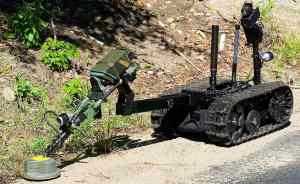Articles >>
QinetiQ extends its TALON robot family to meet challenges of mine detection and counter-IED in Afghanistan
Category: Robots

QinetiQ has extended its TALON family of robots, 2,500 of which have already been deployed in Iraq and Afghanistan, to ensure it continues to meet the ever-changing demands of detecting and clearing mines, unexploded ordnance and dangerous improvised explosive devices (IEDs) from a safe distance. Detection and clearance of mines is of particular importance in Afghanistan, where large numbers of landmines litter the countryside as a result of almost continuous fighting since the late 1970s injuring 200,000 people according to United Nations estimates. The new TALON IV Engineer robot is particularly well suited to operations in the region with a longer, stronger reach, stronger grasp, and the ability to right itself. “Our TALON IV Engineer robot, with its extra strength and reach expands the capabilities of troops to remotely clear routes, minefields or other hazardous areas. And as with other TALON models it gives them the ability to see inside and around vehicles and other barriers, helping increase their overall safety,” explained Dr William Ribich, president of QinetiQ’s US Technology Solutions Group. “TALON robots are extensively used by US forces and have already helped save thousands of explosive ordnance disposal and combat engineers from injury or possible death in the performance of their mission to clear mines and disarm IEDs. This new model delivers greater flexibility and means they can safely detect and deal with a greater variety of threats from a distance.” Key features of the TALON IV Engineer robot include a full-swivel manipulator arm combined with a seven-foot reach. This means a portable mine detector can be taken out of a soldier's hands and mounted on the robot, so the search can be conducted remotely. Because the arm is longer, stronger and able to swivel, the robot can now also be used to remotely search inside bins, in higher vehicle cabs and flatbeds plus behind guard rails or other obstacles. The arm is also capable of lifting 65 pounds (30 kilograms), which means soldiers can clear heavy debris off IEDs remotely too. |

Since its initial deployment in 2000, the TALON family of robots has expanded to include small, medium and large robots devoted to specific tasks, such as IED disposal, reconnaissance, hazardous materials detection, combat engineering support and Special Weapons And Tactics (SWAT) unit assistance. New robots introduced in the last year include MAARS™ and Dragon Runner™ SUGV which address the military’s need for standoff protection, over and above the successful use of TALON for counter-IED missions. Today, 2,500 TALON robots are deployed with the US military – far surpassing the deployment of any other military-use robot. They are also being evaluated or used by a growing number of other military and civil customers. Dr Ribich concluded: “Combined with QinetiQ’s global repair and maintenance footprint, we provide complete mission support. The TALON family of robots stands ready to assist troops and security forces in any corner of the globe.” |
QinetiQ |
QinetiQ and Pratt Miller Deliver First Robotic Combat Vehicle - Light to U.S. Army
02.02.2021
General Dynamics Land Systems–UK showcases adaptable Foxhound vehicle at DSEI 2019
23.09.2019
UK Army Robotics Receive GBP66 M Boost
07.03.2019
Triple-digit million euro contract for Rheinmetall
14.10.2018
TALON (Robot, Unmanned Vehicle)
Hafeet 640 Talon (Armoured car)
Discuss
